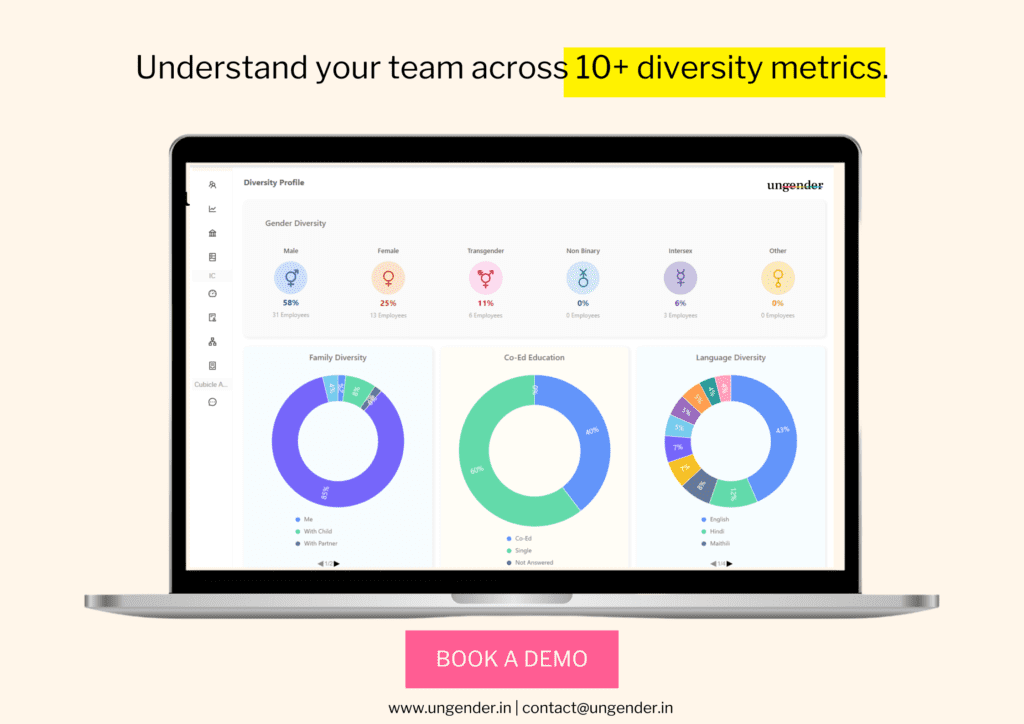The significance of diversity within the workplace has never been more crucial in the present fast-paced and globally connected business environment. Diversity metrics serve as a vital tool for organisations aiming to harness a wide array of perspectives, backgrounds, and talents to foster innovation, drive productivity, and maintain a competitive edge. Understanding these metrics is vital for DEI advisors, practitioners, and Culture Leaders to ensure data-driven strategies and their implementation.
By actively measuring and understanding the multifaceted aspects of diversity through diversity metrics, companies can unlock the full potential of their teams, leading to more innovative solutions and a stronger, more cohesive work environment. Team diversity analysis will enable organisations to make DEI initiatives more targeted and precise.
Emphasising the positive impact of diverse teams on innovation and productivity not only aligns with strategic business goals but also reflects a commitment to creating an inclusive culture that values every employee’s unique contributions.
10 Metrics to Understand Your Team’s Diversity
The diversity metrics encompass not just the traditional metrics of demographic diversity but extend to cultural, educational, and professional backgrounds, among others. Each dimension of diversity offers unique insights and advantages that, when effectively integrated, can significantly enhance organisational performance and innovation. It offers a wealth of insight into your team’s diversity analysis.
- Demographic diversity involves understanding the distribution of age, gender, ethnicity, and nationality within your team. This metric is foundational for creating equitable opportunities and recognizing the visible aspects of diversity that contribute to varied life experiences and perspectives.

Understand your team’s diversity across 10 metrics like age, gender, schooling, previous work experience etc. - Cultural and geographical backgrounds assess the variety of cultures and geographic locations from which team members originate. It is important because it influences individual worldviews, problem-solving approaches, and creativity, enriching the workplace with diverse insights.
- Educational backgrounds track the range of educational paths, including degrees, fields of study, and institutions attended. This diversity fosters a multifaceted skill set and promotes innovative solutions by combining different academic approaches and theories.
- Professional experience looks at the variety of career paths, industries, roles, and professional experiences among team members. It is crucial for bringing diverse professional perspectives, enhancing problem-solving, and facilitating knowledge sharing.
- Cognitive diversity focuses on the differences in how people think, learn, and solve problems. It’s vital for innovation as it ensures a variety of thought processes are considered, leading to more comprehensive and creative solutions.
- Socioeconomic backgrounds consider the economic, social, and familial backgrounds of employees, which shape their experiences and viewpoints. It’s important for fostering empathy, understanding, and a more inclusive work culture.
- Language and communication styles encompass the diversity of languages spoken and the variety of communication preferences. It enhances global communication skills, team dynamics, and the ability to reach diverse customer bases.
- Personality types involve understanding a team’s mix of introverts, extroverts, and ambiverts. Balancing these types supports effective collaboration, leadership, and workplace harmony.
- Disability and accessibility measures the inclusivity of the workplace for individuals with disabilities. It’s crucial for ensuring equal opportunities, compliance with legal standards, and fostering an environment where all talents can thrive.
- Engagement and inclusion metrics evaluate how included and engaged employees feel within the organisation. This metric is key to assessing the effectiveness of diversity and inclusion initiatives, impacting employee retention, satisfaction, and overall company culture.
Organisations can unlock the full potential of their workforce by prioritizing and nurturing all aspects of diversity, from demographic to cognitive and beyond. Team diversity analysis also enables sustainable growth and competitiveness in a rapidly changing world.
To enable organisations to measure diversity across various metrics, we introduced a ‘Diversity Dashboard’ on GetConduct. With GetConduct, you can take a significant step towards fostering an inclusive workplace. Diversity Dashboard transforms how you perceive and manage your organisation’s diversity, offering a clear, visual representation of various diversity metrics such as gender, age, work experience, family background, and language.
For instance, with the Diversity Dashboard on GetConduct, you will know that on average an organisation’s gender diversity ratio of cis men and women is 3:1. This data will enable you to introduce relevant policies and initiatives for increasing gender diversity, ensuring that the workplace is safe and conducive for different team members to work in, and making everyone feel belonged.
These insights are collected right at the time of employee onboarding, enabling you to tailor your diversity initiatives precisely, ensuring that your workplace is genuinely inclusive and welcoming for everyone.
Employee Inclusion Metrics
Employee inclusion metrics focus on gauging the depth of an employee’s engagement, satisfaction, and sense of belonging within an organisation. These metrics are crucial as they directly correlate with productivity, retention rates, and overall workplace morale.
- Employee Net Promoter Score (eNPS): This score is derived from asking employees how likely they are to recommend their workplace to others. It serves as a clear indicator of overall employee satisfaction and loyalty, reflecting the workplace’s appeal.
- Employee engagement surveys: These surveys are designed to capture employees’ enthusiasm and commitment towards their jobs and the organisation’s objectives. They help in identifying areas that can enhance employee motivation and connection to the company.
- Turnover rates: Analyzing voluntary turnover rates provides insights into employee satisfaction, with higher rates potentially indicating dissatisfaction or disconnect with the workplace environment or culture.
- Diversity and inclusion surveys: These surveys evaluate employees’ perceptions of inclusivity, equality, and fairness within the organisation. The feedback helps in pinpointing areas needing improvement to foster a more inclusive workplace.
- Sense of belonging index: This metric assesses how valued and integrated employees feel within the organisation. A strong sense of belonging is linked to increased productivity and lower turnover rates.
- Career progression opportunities: This measures employees’ perceptions of their opportunities for growth and advancement within the company. It impacts how engaged and invested employees are in their roles and the organisation’s future.
By monitoring these metrics, organisations can better understand their employees’ experiences, fostering a more inclusive and engaging work environment.
Benefits of a Diverse Workforce
A diverse workforce brings numerous benefits, including enhanced creativity and innovation, as different perspectives lead to novel solutions. It also improves employee satisfaction and engagement, fostering a more inclusive environment where everyone feels valued. Diversity enhances decision-making quality by incorporating a wide range of viewpoints, leading to better business outcomes. Additionally, it mirrors a global customer base, enabling companies to better understand and cater to varied customer needs, thereby expanding market reach and competitiveness.
Strategies for Diverse Teams
Building and maintaining diverse teams requires intentional actions and strategies aimed at creating an equitable workplace.
- Use standardised job descriptions and blind resume screening to reduce unconscious bias.
- Encourage open communication and respect for all voices, ensuring everyone feels heard and valued.
- Provide training to all employees to raise awareness about biases and teach inclusive behaviours.
- Establish mentorship opportunities for underrepresented groups to support their career development and growth.
- Track and assess diversity metrics to identify progress and areas needing improvement, adjusting strategies as necessary.
Ultimately, these strategies contribute to a more dynamic, innovative, and competitive organisation, where every individual has the opportunity to thrive.
GetConduct stands at the forefront of fostering inclusive workplaces by integrating cutting-edge technology with a strong commitment to ethical practices. With its innovative Diversity Dashboard, Conduct empowers organisations to visualise their diversity through detailed graphs and pie charts, offering insights into gender, age, experience, and more.
This platform is designed with human-centric compliance at its core, making it easier for employees to report workplace misconduct while ensuring anonymity and safety.
GetConduct’s suite of features, including e-learning modules, an incident reporting system, and comprehensive case management, streamlines the process of creating a culture of accountability. By leveraging GetConduct, organisations can not only comply with regulations but also cultivate an environment where every employee feels valued and included, driving towards the ultimate goal of transforming workplace culture for the better.
Conclusion
In conclusion, the journey towards cultivating a diverse and inclusive workplace is ongoing and vital for organisational success. By embracing diversity metrics, organisations can unlock a treasure trove of innovation, productivity, and engagement. The introduction of platforms like GetConduct signifies a pivotal step in this journey, offering tools that not only track but also drive improvements in diversity and inclusion. As we move forward, the imperative for organisations is clear: adopt and integrate inclusive practices to ensure sustained growth and a truly vibrant workplace culture.
Author: Sidra Javed is the Head of Growth & Partnerships at Ungender. Her writing stems from the consultation that she provides to Culture Leaders across various sectors on building a safe and inclusive culture for their teams. Her approach is grounded in lived experiences and open conversations around workplace inclusivity.











